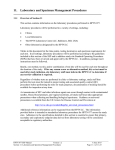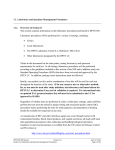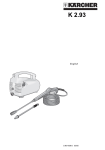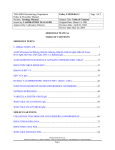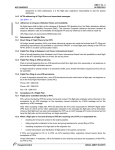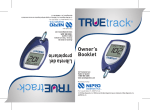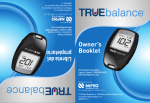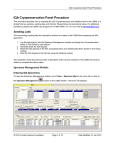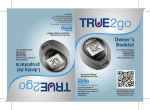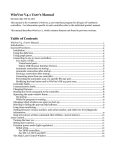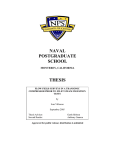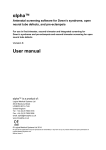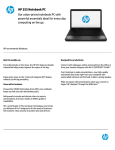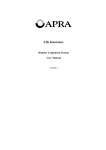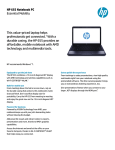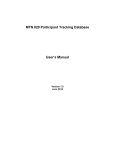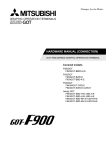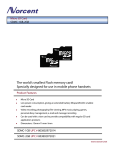Download 11. Laboratory and Specimen Management Procedures
Transcript
11. Laboratory and Specimen Management Procedures 11.1 Overview of Section 11 This section contains information on the laboratory procedures performed in HPTN 077. Laboratory procedures will be performed in a variety of settings, including: Clinics Local laboratories The HPTN Laboratory Center (LC, Baltimore, MD, USA) Other laboratories designated by the HPTN LC Tables in this document list the time points, testing location(s), and specimen requirements for each test. In all settings, laboratory procedures will be performed according to the guidelines included in this section of the SSP and in addition study site Standard Operating Procedures (SOPs) that have been reviewed and approved by the HPTN LC. In addition, package insert instructions must be followed. Ideally, one method, test kit, and/or combination of test kits will be used for each test throughout the duration of the study. If for any reason a new or alternative method, kit, or test must be used after study initiation, site laboratory staff must inform the HPTN LC to determine if any test kit validation is required. Regardless of whether tests are performed in clinic or laboratory settings, study staff that perform the tests must be trained in proper testing and associated quality control (QC) procedures before performing the tests for study purposes; documentation of training should be available for inspection at any time. As transmission of HIV and other infectious agents can occur through contact with contaminated needles, blood, blood products, and vaginal secretions, all study staff must take appropriate precautions when collecting and handling biological specimens. Guidance on universal precautions is available from the US Centers for Disease Control and Prevention at: http://www.cdc.gov/ncidod/dhqp/bp_universal_precautions.html Additional reference information can be requested from the HPTN LC. The information provided below is intended to standardize laboratory procedures for HPTN 077 across the study sites. Adherence to the specifications detailed in this section is essential to ensure that primary, secondary and exploratory endpoint data derived from laboratory testing will be considered acceptable to regulatory authorities. HPTN 077 SSP Manual Version 1.1 Section 11: Laboratory and Specimen Management Procedures 08 April 2015 Page 11-1 of 11-22 11.2 Specimen Labeling All containers into which specimens are initially collected (e.g., blood collection tubes) will be appropriately labeled according to local practices. Participant Identification (PTID) labels will be provided by the HPTN Statistical Data and Management Center (SDMC, SCHARP) if required for this function. LDMS Tracking Forms will also be provided for use if required although sites may use their own specimen transport documentation. The staff member who collects the samples will ensure the visit code, specimen collection date and time as well as their initials or code is documented. More detailed information about the labeling procedures must be provided in the site’s Chain of Custody SOP. When specimens are tested at the laboratories, any additional labeling required for in-country specimen management or chain of custody will be performed in accordance with site-specific SOPs. Stored specimens will be entered into the LDMS and labeled with LDMS-generated labels. 11.2.1 Local Specimen Processing and Storage For samples that are processed and stored locally, each sample will be labeled and entered into the LDMS 11.2.2 Local Specimen Testing Sites will follow local testing arrangements for the collection and testing of samples, this will be described in the site SOPs. All lab results must be recorded following local guidelines. 11.2.3 Remote Specimen Testing Samples that will be sent to the HPTN LC will be labeled and entered into the LDMS. 11.2.4 Use of the LDMS LDMS must be used at all sites to track specimens that will be tested, stored, or shipped off-site for testing. Detailed instructions for use of LDMS are available in the LDMS User Manual: https://www.fstrf.org/apps/cfmx/apps/ldms/ldmsManual/webhelp/index.html As of the date of this version of the SSP, the current version of LDMS is Version 9.0.1. All sites should upgrade to this version as soon as possible. All sites must use the HPTN barcode label format in order to ensure that both the specimen ID and the global specimen ID assigned to each specimen are printed on LDMS-generated labels. HPTN 077 SSP Manual Version 1.1 Section 11: Laboratory and Specimen Management Procedures 08 April 2015 Page 11-2 of 11-22 An example of a two-dimensional LDMS-generated barcode label is below: Row 1: Row 2: Row 3: Row 4: Row 5: LDMS Specimen ID Global Specimen ID Patient Identifier (ID1) and Study/Protocol Identifier (ID2) Specimen Date or Harvest Date and Specimen Collection Time Primary Type, Additive Type, Derivative Type, and Sub Additive/Derivative Type Row 6: Volume/Volume Unit and Visit/Visit Unit (VID) Row 7: Other Specimen ID (if applicable) Questions related to use of LDMS for HPTN 077 should be directed to Paul Richardson ([email protected]). Technical support for the general use of LDMS is available from Frontier Science. LDMS User Support at Frontier Science Regular Hours: Monday to Friday, 12:00 AM to 6:00 PM (Eastern Standard Time) Off-hours: See below Email: [email protected] Phone: +1 (716) 834-0900, extension 7311 Fax: +1 (716) 832-8448 (should be used to fax Installation Reports only) LDMS User Support can be contacted during off-hours, as well as on weekends on U.S. holidays, by completing the LDMS help form on the Frontier Science portal. This form can be found on the portal by clicking the “Contact LDMS User Support” link. You will need a portal account to access this form. While it is preferred that users use the “Contact LDMS User Support” link on the portal, there may be times when you need immediately assistance during off-hours and cannot access the portal. In these situations, you can contact LDMS User Support by emailing the pager email addresses directly. Pager 1: Pager 2: Pager 3: [email protected] [email protected] [email protected] Try pager 1 first. If you do not receive a response within 15 minutes, try pager 2, and then finally pager 3. HPTN 077 SSP Manual Version 1.1 Section 11: Laboratory and Specimen Management Procedures 08 April 2015 Page 11-3 of 11-22 When you contact LDMS user support, there are certain pieces of information that you can provide to help them better respond to your question. Please provide the following information in your email support: 1. Your name 2. Your laboratory’s LDMS ID number This is a 3-digit number assigned by Frontier Science to uniquely identify your laboratory. It appears when you start LDMS, and can also be found in the bottom-right corner of the screen. 3. A full explanation of the issue Your explanation should include any error messages or error numbers that appeared, what you were doing in LDMS at the time the issue occurred, and steps needed to reproduce the issue. The more details that you can provide, the faster LDMS User Support can help you. 4. How you want to be contacted If you want LDMS user support to call a specific telephone number, please provide that number and extension. 5. (If applicable) The license code or challenge code being generated by LDMS Note: If you are contacting user support about a license or challenge code, do not close the window with the code. Doing so will cause LDMS to generate a new code. Below are a few other details that can also be helpful to include in your email: 1. Have there been any recent changes to the computer with LDMS, such as new hardware installed, a firewall upgrade, a network name change, or another change? 2. Are you or another user able to repeat the issue? 3. If you have LDMS installed on multiple computers, does the issue occur on all of them or does it only occur on a specific computer? Each site must export its LDMS data to Frontier Science (FSTRF) on a weekly basis or whenever changes or additions are made to the LDMS database. Exported data are used by the HPTN SDMC to generate a discrepancy reports comparing the data from the LDMS with that entered onto the CRFs. Any discrepancies identified during the reconciliation are included in a discrepancy report for each site. Sites are expected to resolve all discrepancies within one week of receipt of the report. The HPTN LC is responsible for reminding sites to adhere to the oneweek timeframe and for following up with sites that do not resolve discrepancies within one week. The HPTN SDMC reviews the discrepancy reports for critical samples (e.g., plasma needed for confirmatory HIV testing) that appear to be missing, and works with the LC and site staff to undertake appropriate corrective action. All corrective action should be documented in paper-based clinic and/or laboratory records as appropriate, and entered in the details section of LDMS. The LC and SDMC will discuss and document any items that, although resolved, appear ‘unresolvable’ in LDMS. Any corrections to the LDMS need to be made following guidelines provided by FSTRF. HPTN 077 SSP Manual Version 1.1 Section 11: Laboratory and Specimen Management Procedures 08 April 2015 Page 11-4 of 11-22 11.2.5 LDMS Reconciliation All sites must follow the HPTN LC approved site-specific SOP for regular reconciliation and verification of specimens that are stored; these SOPs must be followed throughout the study. All sites must also create a Primary Specimen report. In the event that the required volume or number of sample aliquots is not obtained at any time point, designated site clinic and lab staff must immediately inform the HPTN LOC, HPTN SDMC and LC. The HPTN LOC, SDMC, and LC will provide guidance on how to respond to the problem. In addition to following this guidance, designated site and lab staff will work together to document the problem, take appropriate corrective and preventive action, and document all action taken. Reconciliation must be performed for all specimen types that are received by the laboratory and stored in the LDMS. 11.3 Protocol related testing and sample collection Samples will be collected and processed at the screening, enrollment, and follow up visits as indicated in table 11-1. If a participant does not receive all three injections, follow the appropriate schedule listed in Tables 11-2 – 11-3. Collect specimens and label tubes according to local regulations and the Blood Collection and Urine Collection SOPs. Blood collection tubes must be filled to the appropriate fill level as indicated by the tube manufacturer. After collection: EDTA tubes (Lavender top) should be gently inverted at least 8 times (or as specified by manufacturer) after specimen collection to prevent clotting. For plasma storage, 20 ml of whole blood should be collected into spray dried EDTA tubes e.g. BD 366643 or other to yield 5 x 1.8mL plasma aliquots HPTN 077 SSP Manual Version 1.1 Section 11: Laboratory and Specimen Management Procedures 08 April 2015 Page 11-5 of 11-22 Table 11-1: Schedule of Study Visits and Specimen Collection – Participants Who Complete All Three Injections. HIV testing1 X HBV and HCV2 X Syphilis serological testing X CBC with Differential X X X X X X X X X X X X X X X Chemistry3 X X X X X X X X X X X X X X X LFT4 (AST, ALT, total bilirubin, alkaline phosphatase) X4 X X X X X X X X X X X X X X 5 Fasting Lipid Profile X X X X X X X X X X X Urine or vaginal swab GC/CT testing 7 X X X X X X X X 10 Plasma for Pharmacology Sample storage for Pharmacogenomic testing10 Week 81 Final Visit Week 77 Tail Phase Week 65 Tail Phase X X X X X X X X X X X X X X X Plasma Storage10 X X X X 9 X X X Rectal swab GC/CT testing8 X X X Urine pregnancy testing6 Urinalysis X Week 53 Tail Phase Week 41 Primary Week 35 Safety Week 30 Safety Week 29 3rd Injection Week 23 Safety Week 18 Safety Week 17 2nd Injection Week 13 Safety Week 9 Safety Week 6 Safety X Week 5 1st Injection X 1 Week Wash Out Week 4 Injection and Tail Phase Follow Up - Weeks Week 2 Day 0 Enrollment Screening Oral Phase X X X X X X X X X X X X X X X X X X X X X X X X X X X X X X X X X X X X11 1. Following the HIV algorithms described in SSP section 11.3.1 HIV testing does not need to be performed after confirmation of HIV infection (based on results from samples collected on two separate dates). At the oral dosing visits (Day 0 and Week 2) and injection visits (Weeks 5, 17, and 29), at least one same day negative or non-reactive HIV test result must be obtained PRIOR to administering the study product. 2. Testing for hepatitis B virus (HBV) and hepatitis C virus (HCV) includes hepatitis B surface antigen (HBsAg), hepatitis B surface antibody (HBsAb), hepatitis B core antibody (HBcAb), and hepatitis C antibody (HCAb). 3. Chemistry testing includes: BUN, urea, Na, K, Cl, CO2, CPK, creatinine, total protein, glucose, calcium, phosphorous, amylase, lipase, and magnesium. 4. LFT at screening to include direct bilirubin. 5. The fasting lipid profile includes total cholesterol, HDL, triglycerides, and LDL (either calculated or measured). Participants should have fasted for at least 8 hours, preferably 12 hours, prior to sample collection. 6. Urine pregnancy testing is required for women of reproductive potential only. The assay used must have sensitivity of ≤25 mIU/mL βHCG. At the oral dosing visits (Day 0 and Week 2) and injection visits (Weeks 5, 17, and 29), a urine pregnancy test must be performed and pregnancy must be ruled out PRIOR to administering the study product. Urine pregnancy testing may be performed in the clinic or the laboratory. Pregnancy testing is not required if a positive result was obtained at a prior visit and the participant is still pregnant. 7. Urine and/or vaginal swab for GC/CT, will be performed at Screening and Weeks 29 and 53. Testing will be performed locally. 8. Rectal swabs for GC/CT will be performed at enrollment and weeks 29 and 53. For US sites testing will be performed locally and the entry sample may be performed at screening instead of enrollment. For non-US sites, rectal swabs will be batched and shipped to the HPTN LC for testing. 9. Urinalysis includes protein and glucose; this testing may be performed in the clinic or the laboratory. Results from urinalysis are not needed prior to enrollment. 10. From 20mL of EDTA whole blood that has been drawn at the same time and date as the sample for HIV testing. See SSP Section 11.4 for specimen processing details. At week 5 this blood for PK must be drawn prior to the administration of study product. 11. Pharmacogenomic testing is at the discretion of the site. HPTN 077 SSP Manual Version 1.1 Section 11: Laboratory and Specimen Management Procedures 08 April 2015 Page 11-6 of 11-22 Table 11-2: Schedule of Study Visits and Specimen Collection – Participants Who Complete Two Injections Only. HBV and HCV2 X Syphilis serological testing X CBC with Differential X X X X X X X X X X X X X Chemistry3 X X X X X X X X X X X X X LFT4 (AST, ALT, total bilirubin, alkaline phosphatase) X4 X X X X X X X X X X X X Fasting Lipid Profile5 X X Urine or vaginal swab GC/CT testing7 X X X X X X X X X Urinalysis9 X X X X Rectal swab GC/CT testing8 X Plasma for Pharmacology10 Sample storage for Pharmacogenomic testing10 X X Urine pregnancy testing6 Plasma Storage10 X Week 69 Final Visit X Week 65 HIV testing1 Week 53 Week 41 Primary Endpoint Week 29 Week 23 Safety Week 18 Safety Week 17 2nd Injection Week 13 Safety Week 9 Safety Week 6 Safety X Week 5 1st Injection Week 4 X Injection and Tail Phase Follow Up - Weeks 1 Week Wash Out Week 2 Day 0 Enrollment Screening Oral Phase X X X X X X X X X X X X X X X X X X X X X X X X X X X X X X X X X X X X X X X X X X X X X X X X X X11 1. Following the HIV algorithms described in SSP section 11.3.1 HIV testing does not need to be performed after confirmation of HIV infection (based on results from samples collected on two separate dates). At the oral dosing visits (Day 0 and Week 2) and injection visits (Weeks 5, 17, and 29), at least one same day negative or non-reactive HIV test result must be obtained PRIOR to administering the study product. 2. Testing for hepatitis B virus (HBV) and hepatitis C virus (HCV) includes hepatitis B surface antigen (HBsAg), hepatitis B surface antibody (HBsAb), hepatitis B core antibody (HBcAb), and hepatitis C antibody (HCAb). 3. Chemistry testing includes: BUN, urea, Na, K, Cl, CO2, CPK, creatinine, total protein, glucose, calcium, phosphorous, amylase, lipase, and magnesium. 4. LFT at screening to include direct bilirubin. 5. The fasting lipid profile includes total cholesterol, HDL, triglycerides, and LDL (either calculated or measured). Participants should have fasted for at least 8 hours, preferably 12 hours, prior to sample collection. 6. Urine pregnancy testing is required for women of reproductive potential only. The assay used must have sensitivity of ≤25 mIU/mL βHCG. At the oral dosing visits (Day 0 and Week 2) and injection visits (Weeks 5, 17, and 29), a urine pregnancy test must be performed and pregnancy must be ruled out PRIOR to administering the study product. Urine pregnancy testing may be performed in the clinic or the laboratory. Pregnancy testing is not required if a positive result was obtained at a prior visit and the participant is still pregnant. 7. Urine and/or vaginal swab for GC/CT, will be performed at Screening and Weeks 29 and 53. Testing will be performed locally. 8. Rectal swabs for GC/CT will be performed at enrollment and weeks 29 and 53. For US sites testing will be performed locally and the entry sample may be performed at screening instead of enrollment. For non-US sites, rectal swabs will be batched and shipped to the HPTN LC for testing. 9. Urinalysis includes protein and glucose; this testing may be performed in the clinic or the laboratory. Results from urinalysis are not needed prior to enrollment. 10. From 20mL of EDTA whole blood that has been drawn at the same time and date as the sample for HIV testing. See SSP Section 11.4 for specimen processing details. At week 5 this blood for PK must be drawn prior to the administration of study product. 11. Pharmacogenomic testing is at the discretion of the site. HPTN 077 SSP Manual Version 1.1 Section 11: Laboratory and Specimen Management Procedures 08 April 2015 Page 11-7 of 11-22 Table 11-3: Schedule of Study Visits and Specimen Collection – Participants Who Complete One Injection Only. X X X HBV and HCV X Syphilis serological testing X CBC with Differential X X X X X X X X X X X 3 Chemistry X X X X X X X X X X X LFT4 (AST, ALT, total bilirubin, alkaline phosphatase) X4 X X X X X X X X X X Fasting Lipid Profile5 X Urine pregnancy testing6 Urine or vaginal swab GC/CT testing X X 7 X X Urinalysis9 X Plasma Storage10 X X Plasma for Pharmacology10 Sample storage for Pharmacogenomic testing10 X X X X X X X X X X X X X Rectal swab GC/CT testing8 Week 57 Final visit X Week 41 Primary Endpoint Week 13 Safety Week 9 Safety X Week 53 X Week 29 X Week 6 Safety Week 5 1st Injection X 1 Week Wash Out X Week 17 X Week 4 X 2 Injection and Tail Phase Follow Up - Weeks Week 2 HIV testing1 Day 0 Enrollment Screening Oral Phase X X X X X X X X X X X X X X X X X X X X X X X X X X X X X11 1. Following the HIV algorithms described in SSP section 11.3.1 HIV testing does not need to be performed after confirmation of HIV infection (based on results from samples collected on two separate dates). At the oral dosing visits (Day 0 and Week 2) and injection visits (Weeks 5, 17, and 29), at least one same day negative or non-reactive HIV test result must be obtained PRIOR to administering the study product. 2. Testing for hepatitis B virus (HBV) and hepatitis C virus (HCV) includes hepatitis B surface antigen (HBsAg), hepatitis B surface antibody (HBsAb), hepatitis B core antibody (HBcAb), and hepatitis C antibody (HCAb). 3. Chemistry testing includes: BUN, urea, Na, K, Cl, CO2, CPK, creatinine, total protein, glucose, calcium, phosphorous, amylase, lipase, and magnesium. 4. LFT at screening to include direct bilirubin. 5. The fasting lipid profile includes total cholesterol, HDL, triglycerides, and LDL (either calculated or measured). Participants should have fasted for at least 8 hours, preferably 12 hours, prior to sample collection. 6. Urine pregnancy testing is required for women of reproductive potential only. The assay used must have sensitivity of ≤25 mIU/mL βHCG. At the oral dosing visits (Day 0 and Week 2) and injection visits (Weeks 5, 17, and 29), a urine pregnancy test must be performed and pregnancy must be ruled out PRIOR to administering the study product. Urine pregnancy testing may be performed in the clinic or the laboratory. Pregnancy testing is not required if a positive result was obtained at a prior visit and the participant is still pregnant. 7. Urine and/or vaginal swab for GC/CT, will be performed at Screening and Weeks 29 and 53. Testing will be performed locally. 8. Rectal swabs for GC/CT will be performed at enrollment and weeks 29 and 53. For US sites testing will be performed locally and the entry sample may be performed at screening instead of enrollment. For non-US sites, rectal swabs will be batched and shipped to the HPTN LC for testing. 9. Urinalysis includes protein and glucose; this testing may be performed in the clinic or the laboratory. Results from urinalysis are not needed prior to enrollment. 10. From 20mL of EDTA whole blood that has been drawn at the same time and date as the sample for HIV testing. See SSP Section 11.4 for specimen processing details. At week 5 this blood for PK must be drawn prior to the administration of study product. 11. Pharmacogenomic testing is at the discretion of the site. HPTN 077 SSP Manual Version 1.1 Section 11: Laboratory and Specimen Management Procedures 08 April 2015 Page 11-8 of 11-22 11.3.1 HIV Testing HIV testing will be performed using blood collected by phlebotomy (no fingerstick oral fluid testing) at participant visits in accordance with the testing algorithms described in Figures 11-1 – 11-3. For further help on implementing the HIV testing algorithm, seek guidance from the HPTN LC. Whole blood will be collected according to site-specific procedures. Participants with one or more reactive HIV test results at either the screening or enrollment visit will not be eligible for enrollment, regardless of subsequent test results. RNA testing for acute HIV infection, which must be performed within 14 days prior to Enrollment. The Protocol Chair, Site PI, CMC and HPTN LC must be notified immediately if one or more reactive HIV test results are obtained at any follow up visit after enrollment. This includes the result of the 4th generation EIA test that is collected at the enrollment visit. Additional HIV testing may be performed at any time at the discretion of the site investigator. HIV infection must be confirmed using two independent samples collected on different days. Plasma storage is required at every visit at which HIV testing is performed. All tests and associated QC procedures must be documented on local laboratory log sheets or other laboratory source documents. Kit lot numbers and expiry dates must also be documented. All staff involved in HIV testing and verification of HIV test results should be aware of the testing time frame for the HIV test, so that all tests are performed and verified within the specified time frame. Place appropriate timekeeping devices in all test settings to ensure that each test is read and verified at appropriate time points. Documentation is required for the testing start and stop times, as well as, result verification times. These must be recorded on testing log sheets. In the event that a participant has a reactive or positive HIV test at Week 2, 4, or 5, study product will be discontinued and the participant will be followed for an additional two visits - Weeks 17 and 29 - and will be terminated from the study at the Week 29 visit. If a participant has a reactive or positive HIV test at any time after enrollment, additional blood draw and testing is required as detailed in Table 11-4. HPTN 077 SSP Manual Version 1.1 Section 11: Laboratory and Specimen Management Procedures 08 April 2015 Page 11-9 of 11-22 Figure 11.1 HIV Testing Algorithm at the Screening Visit: HPTN 077 SSP Manual Version 1.1 Section 11: Laboratory and Specimen Management Procedures 08 April 2015 Page 11-10 of 11-22 Figure 11.2 HIV Testing Algorithm at the Enrollment Visit: HPTN 077 SSP Manual Version 1.1 Section 11: Laboratory and Specimen Management Procedures 08 April 2015 Page 11-11 of 11-22 Figure 11.3 HIV Testing Algorithm at Follow Up Visits: HPTN 077 SSP Manual Version 1.1 Section 11: Laboratory and Specimen Management Procedures 08 April 2015 Page 11-12 of 11-22 Table 11-4: Additional Procedures for Participants who have a Reactive or Positive HIV test at any Time after Enrollment. The additional blood draw for HIV testing and plasma storage should be performed on a different date than the blood draw that gave the initial reactive or positive HIV test. HIV confirmation visit following a reactive or positive HIV result. HIV testing1. X CD4 cell count. X HIV resistance testing2. X Additional plasma storage3. X HIV Viral Load X 1. 2. 3. Following approved HIV testing algorithm shown in figure 11.3. If HIV rapid testing is included in the HIV testing algorithm, this testing may be performed in the clinic or the laboratory. Sites may collect specimens for resistance testing at a local laboratory to assist with clinical management; results from resistance testing performed at local laboratories will not be reported to the SDMC. Stored plasma may not be used for real-time/local resistance testing. Obtained from 20mL of EDTA whole blood that has been drawn at the same time and date as the sample for HIV testing. See SSP Section 11.4.1 for specimen processing details. HPTN 077 SSP Manual Version 1.1 Section 11: Laboratory and Specimen Management Procedures 08 April 2015 Page 11-13 of 11-22 11.3.2 Hepatitis Testing Testing for HBV (HBsAb, HBsAg, HBcAb) and HCV will be performed at Screening. Sites will follow local testing arrangements for the collection and testing of samples, this will be described in the site SOPs. Test results are required for the enrollment visit. Persons with a positive HBsAg and/or HCV antibody test will be excluded from the study. 11.3.3 Safety Testing CBC, Chemistry and LFTs will be performed at various time points throughout the study. Sites will follow local testing arrangements for the collection and testing of samples, this will be described in the site SOPs. Test results from the screening visit are required prior to enrollment. Same day test results are not required prior to the issue of study product. 11.3.3.1 Creatinine Clearance Calculated creatinine clearance will be performed at all visits where chemistry testing is performed, using the Cockcroft-Gault formula. For Males: eCcr (male) in mL/min = [(140 - age in years) x (actual body weight in kg)] / (72 x serum creatinine in mg/dL). For Females: eCcr (female) in mL/min = [(140 - age in years) x (actual body weight in kg) x .85] / (72 x serum creatinine in mg/dL). 11.3.4 Urine Pregnancy Testing All women of reproductive potential will have a urine βHCG test for pregnancy (sensitivity of ≤ 25 mIU/mL) at each visit. Pregnancy testing is not required at subsequent visits if a woman had a positive pregnancy test at a previous visit and is still pregnant. Sites will follow local testing arrangements for the collection and testing of samples, this will be described in the site SOPs. The test result from the screening visit is required prior to enrollment. HPTN 077 SSP Manual Version 1.1 Section 11: Laboratory and Specimen Management Procedures 08 April 2015 Page 11-14 of 11-22 For women of reproductive potential, a pregnancy test result from the same visit must be available and confirmed to be negative PRIOR to the provision or continuation of study product. This is a requirement at all visits at which study product is to be administered or continued (enrollment, weeks 2, 4, 5, 17 and 29). Study product must NOT be given if the pregnancy test obtained at this or the prior visit is positive. In the event that a female participant has a positive pregnancy test at Weeks 2, 4, or 5, study product will be discontinued and the participant will be followed approximately every 12 weeks starting at the Week 17 visit until pregnancy outcome is reached. Once pregnancy outcome is reached, the participant will be terminated from the study. 11.3.5 Fasting Lipid Profile A fasting lipid profile (total cholesterol, HDL, triglycerides, LDL – calculated or measured) will be collected at the enrollment and week 41 visits. Participants should be fasting for at least 8 [preferably 12] hours prior to sample collection. Sites will follow local testing arrangements for the collection and testing of the lipid profile. This will be described in the site SOPs. Results from the lipid profile at the enrollment visit are NOT required prior to the issue of study product. 11.3.6 Urinalysis Testing Sites will follow local testing arrangements for the collection and testing of urine for urinalysis (only for protein and glucose). This will be described in the site SOPs. Results from the enrollment visit are not required prior to enrollment. 11.3.7 Syphilis Testing Sites will follow local testing arrangements for the collection and testing of plasma for syphilis testing. This will be described in the site SOPs. Results from the screening visit are required prior to enrollment. 11.3.8 Urine Sample or Vaginal Swab for GC/CT Testing. Sites will follow local testing arrangements for the collection and testing of urine sample or vaginal swabs for GC/CT. This will be described in the site SOPs. Results from the screening visit are required prior to enrollment. HPTN 077 SSP Manual Version 1.1 Section 11: Laboratory and Specimen Management Procedures 08 April 2015 Page 11-15 of 11-22 11.3.9 Rectal Swab Collection for GC/CT Rectal swabs for GC/CT will be collected at enrollment, weeks 29 and 53. US sites only may perform baseline rectal swabs at the screening or the enrollment visit. US sites will follow local testing arrangements for the collection and testing of rectal swabs for GC/CT testing. It is preferred that all rectal swabs be provider-performed. Self-collect swabs are acceptable as a second choice if provider-performed collection is not possible. Results from the screening visit are not required prior to enrollment. Samples collected at non-US sites will be stored for batched shipment for testing at the HPTN Laboratory Center (LC), or a laboratory approved by the LC. Specimens for shipment the HPTN LC should be collected as follows: 11.3.9.1 Rectal Swabs for GC/CT Testing at the HPTN LC It is preferred that all rectal swabs be provider-performed. Self-collect swabs are acceptable as a second choice if provider-performed collection is not possible. It is recommended that the GenProbe Transport kit be used for rectal swabs that are to be tested for CT/GC. The kit contains swab and transport media – Order information is as follows: Aptima Vaginal Swab Specimen Collection Kit Available from Gen-Probe Catalogue number 301162 Rectal specimens will be collected, stored and transported as follows: HPTN 077 SSP Manual Version 1.1 Section 11: Laboratory and Specimen Management Procedures 08 April 2015 Page 11-16 of 11-22 Clinician Collected 1. Participant will be asked to remove or pull down pants and either lie on left side on exam table or bend over table with chest on table and buttock exposed. 2. Provider will at same time wash hands and put on disposable latex free gloves. 3. Provider will peel open the wrapper containing the swab taking care to not touch the tip of the swab (do not place any water, lubricant or other fluid on swab). 4. Insert swab into rectum 1 ½ inches from the tip of the swab and rotate 180 degrees making sure to touch the walls of the rectum. Remove swab in a circular motion. 5. Screw the cap off the collection tube and place the swab in the tube. 6. Bend the shaft of the swab until the part sticking out breaks off. 7. Place the cap tightly on the tube to prevent leakage during transporting. 8. Samples should be transported to the testing laboratory or to the LDMS laboratory for LDMS entry and storage at -70oC or below. Samples are stable for up to 60 days in GenProbe transport tubes when stored at 2-8oC. Samples can also be frozen at -70oC or below, but not at -20oC. LDMS Specimen Code for Rectal Swab (required for samples shipped to the HPTN LC) Test Rectal swab for GC/CT Primary LDMS Code REC Additive VTM Derivative Sub Add/Deriv SWB N/A Codes used in table: REC Rectal VTM Viral Transport Media SWB Swab 11.4 Plasma Processing for Storage 20 mL of EDTA whole blood will be drawn for plasma storage at each time point at which HIV testing is performed as indicated in Tables 11.1 – 11.5. Sites are requested to store 5 x 1.8 mL aliquots of plasma if possible. HPTN LC should be informed at any time that three or less aliquots of 1.8mL are stored. This plasma will also be used for pharmacogenomic analysis at the enrollment visit (I consent obtained) and pharmacology at subsequent visits. An additional 20 mL of EDTA whole blood will be drawn for plasma storage for participants with a reactive or positive HIV test at any time after enrollment as indicated in Table 11.3. This additional plasma will be stored in the same way. HPTN 077 SSP Manual Version 1.1 Section 11: Laboratory and Specimen Management Procedures 08 April 2015 Page 11-17 of 11-22 Sites will follow site specific SOPs for plasma processing which will include the following: Collect blood into lavender top blood collection tubes (EDTA) labeled with a SCHARPprovided PTID label. Size and number of collection tubes may vary depending on local lab requirements. Deliver this to the local LDMS laboratory along with the LDMS Specimen Tracking Sheet or site specific requisition. Using the LDMS Specimen Tracking Sheet, log the sample into LDMS (specimen type = BLD) and generate the appropriate number of LDMS cryovial labels. The lab should store plasma in labeled cryovials. Cryovial size may vary, but 2.0 mL is recommended. Reminder these vials hold 1.8 mL of liquid. Do not add more than 1.8 mL due to expansion issues when freezing. Blood processing and plasma storage should be performed within 6 hours of sample collection. Centrifuge tube at 800 - 1000 x g for 10 minutes to separate cells and plasma. Carefully remove plasma and avoid disturbing the cell layer. Transfer the plasma to an appropriately labelled sterile centrifuge tube. Centrifuge plasma again at 800 - 1000 x g for 10 minutes to remove any contaminating debris, cells, or platelets. Log samples into LDMS and generate LDMS labels. (PL2) Each aliquot will have its own individual identification number (Global Specimen ID). Store plasma in aliquot number order. For example if there is only 3 mL of plasma for archive, store 1.8 mL in aliquot 1. Store the remaining 1.2 mL in aliquot 2 and adjust the aliquot volume in LDMS to indicate 1.2 mL. Store the aliquots in the freezer locations assigned in LDMS in a minus 70 to minus 90 freezer. Plasma for storage will be stored on site until all protocol-related testing is complete. Note that some testing will be performed after study visits have been completed. Study sites should plan to store specimens until all of the protocol specified testing (including assessments at the HPTN LC) has been completed and the primary research paper has been published. HPTN 077 SSP Manual Version 1.1 Section 11: Laboratory and Specimen Management Procedures 08 April 2015 Page 11-18 of 11-22 LDMS Entry: LDMS Specimen Code for Plasma Storage Primary LDMS Code Additive Derivative Test Plasma Storage BLD EDT PL2 Sub Add/Deriv N/A Codes used in table: BLD Blood EDT EDTA PL2 Plasma, Double Spun N/A Not Applicable Other Spec ID: Not Applicable All plasma vials are stored in the LDMS and in a -70C to -90C freezer. Selected aliquots will be shipped to HPTN Laboratory Center (LC) when requested. All enrolled study participants must consent to collection and storage of their plasma for the duration of their study participation and until all protocol-specified testing has been completed. Participants are asked to consent separately to indefinite storage and possible future research testing of their plasma after the study is completed. Participants may refuse to consent to indefinite storage and possible future research testing and still enroll in the study. After all protocol-specified testing has been completed; the stored plasma of participants who do not consent to indefinite storage and possible future research testing must be destroyed. After all protocol-specified testing has been completed, the HPTN SDMC will provide each site with a list of participants who did not consent to indefinite storage and possible future research testing and the HPTN LC will provide detailed instructions for specimen destruction and documentation thereof. HPTN 077 SSP Manual Version 1.1 Section 11: Laboratory and Specimen Management Procedures 08 April 2015 Page 11-19 of 11-22 11.5 Shipping of Samples to the HPTN Laboratory Center Each site will ship plasma samples to the LC upon request. The site will batch the shipment, export the LDMS data and notify the SDMC and LC. Additional samples may be specifically requested by the HPTN LC (e.g., archive/back-up samples); in this case, the SDMC will provide the site(s) with specific shipping lists. Contact the HPTN LC at Johns Hopkins University (Estelle Piwowar-Manning: [email protected], +410-614-6736) and Paul Richardson: [email protected] to coordinate the timing and logistics of each shipment. Sites will ship samples to the LC using the LDMS following the LC approved Shipping SOP Indicating Lab 300 as the ship to lab ID number. The site should export the data to FSTRF after a batch has been made and notify SCHARP and HPTN LC with the batch number. Personnel involved in the shipping process must be IATA trained and certified for the shipping of Category B Biological specimens UN 3373 (Diagnostic) Packing Instructions 650. Include a copy of the shipping manifest and box map. For dry ice shipments, use diagnostics packing code 650, UN 3373, and address the shipment to: Estelle Piwowar-Manning Johns Hopkins University Hospital Department of Pathology Pathology Building, Room 311 600 North Wolfe Street Baltimore, MD 21287 USA Notify the HPTN LC via email ([email protected]) when the shipment has been picked up from the site by the courier/shipping company. Attach an electronic copy of the shipping manifest and LDMS batch to the email notification, and include the following information in the notification: name of courier/shipping company, shipment tracking number, number of boxes shipped, date of shipment, and expected date of arrival. The following types of specimens will be shipped to the HPTN LC for testing: HPTN 077 SSP Manual Version 1.1 Section 11: Laboratory and Specimen Management Procedures 08 April 2015 Page 11-20 of 11-22 11.5.1 HIV QA Testing Selected plasma aliquots will be shipped to the HPTN LC for HIV QA testing according to the HPTN Manual of Operations; additional testing may be performed e.g. ABO typing. When samples are received at the HPTN LC, the LC will perform additional QA and HIV testing. This will include: Quality assurance testing (to confirm results of in-country testing) Testing to confirm seroconversion events Data from the HPTN LC will be submitted to the SDMC. 11.5.2 Pharmacology Testing Plasma samples for drug levels will be collected beginning at Week 2 through and including the last study visit at Week 81. These samples will collected from all participants, although PK testing may be limited to a subset of the samples. At each injection visit a blood sample will be collected PRIOR to the injections at Weeks 5, 17 and 29. The actual date and time of each blood sample collection will be recorded, as well as the time of each injection. This information should be captured on the relevant CRF. Specimens for pharmacology testing will be stored on site for shipment to the HPTN LC upon request. Pharmacology testing will be performed at the HPTN LC or at an outside laboratory designated by the HPTN LC. The primary pharmacologic assessments will be performed using assays that have been validated and approved by the Clinical Pharmacology Quality Assurance (CPQA) Committee. Results will not be returned to the sites or study participants. Stored plasma may also be tested for the presence of other ARV drugs or other substances. 11.5.3 Pharmacogenomic Testing Specimens for pharmacogenomic analysis will be collected at the enrollment visit for participants who consent to Pharmacogenomic testing. Samples will be stored on site for shipment to the HPTN LC upon request. Assays will be performed at the HPTN LC. Results will not be returned to the sites or study participants. 11.5.4 GC/CT Rectal Swab Storage (Non US Sites Only) Testing for GC/CT in men and women (rectal swab), will occur at Enrollment (or screening – US sites only) and Weeks 29 and 53. At US sites, testing will be performed at the local laboratory. At non-US sites, samples will be stored for non-real-time, batched testing at the HPTN LC or designated laboratory. These samples will be shipped upon request by the HPTN LC. The HPTN LC may ask sites to store other specimen types for STI testing at the HPTN LC if the site is not able to perform the testing. HPTN 077 SSP Manual Version 1.1 Section 11: Laboratory and Specimen Management Procedures 08 April 2015 Page 11-21 of 11-22 11.5.5 Other Testing The HPTN LC will perform QA testing, including testing to determine HIV infection status in selected cases. Additional assays may be performed at the HPTN LC or a laboratory designated by the HPTN LC. This testing may include the following tests for participants who acquire HIV infection: HIV viral load, HIV resistance testing, HIV subtyping, and other tests to characterize HIV viruses and/or the host response to HIV infection. Results will not be returned to the sites or study participants, with the exception of HIV testing (if results obtained at the HPTN LC do not agree with site results) and the exception for resistance test results, noted below. Resistance testing will be performed at the HPTN LC or a laboratory designated by the HPTN LC. This testing will be performed retrospectively at the end of the study. If real-time resistance testing is needed for clinical management, that testing should be arranged by the site outside of the study; separate specimens should be collected for that testing. For sites that do not have the capacity for local resistance testing for clinical care, results from resistance testing may be provided at the end of the study at the request of the site IoR, with approval of the HPTN LC and Protocol Chair. Results from specialized resistance testing (e.g., minority variants analysis, if performed) will not be returned to study sites. 11.6 Laboratory Monitoring LC staff will conduct periodic site visits to review in-clinic documentation, LDMS reports, specimen storage and other laboratory documentation relevant to this protocol. HPTN 077 SSP Manual Version 1.1 Section 11: Laboratory and Specimen Management Procedures 08 April 2015 Page 11-22 of 11-22






















